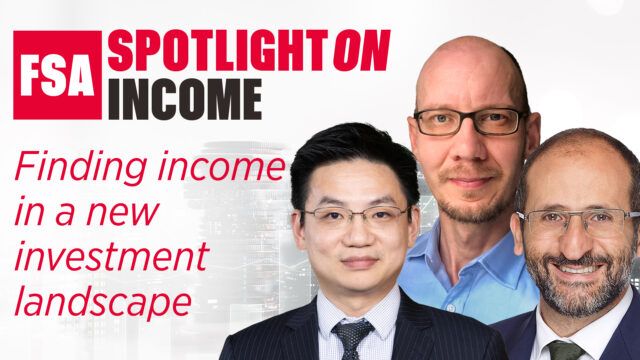How is the current rates cycle impacting your outlook for income opportunities?

Managing director and portfolio manager, ClearBridge Investments
Charles: Given our base case of slowing growth, higher inflation and rising interest rates, our playbook for infrastructure is to watch for a transition from a growth orientation, in which we prefer higher exposure to economically sensitive user-pays infrastructure and lower utility weightings, to a more defensive positioning as growth fades and utility underperformance unwinds.
We think this will be a measured process through 2022, although we remain cognisant that the transition from a growth posture to a defensive one may accelerate should the outlook worsen faster than expected. We would look for defensive growth exposure through communications and high-growth utilities, including renewables, and ensure that our position in utilities exhibit strong correlation to inflation.

Fund manager,
M&G Investments
James: The historic global monetary tightening cycle that we are currently experiencing is having profound implications on financial markets and asset valuations. As central banks have increased interest rates and withdrawn liquidity to counter persistently high levels of inflation, traditional bond asset classes have suffered.
We believe low duration and high income bond strategies are best placed to thrive in the current market environment. We therefore advocate investing in high yield floating rate bonds, which due to their variable coupon structure pay increasing levels of income as interest rates rise. With the US Federal Reserve expected to hike rates many more times this year, we believe now is an opportune time to invest in high yield floating rate bonds.

Portfolio manager and head of Asia ex-Japan credit research, PineBridge Investments
Andy: Persistently higher inflation exacerbated by elevated energy and food prices will continue to pressure the Federal Reserve into tightening financial conditions in the near term irrespective of the growth outlook, consolidating our view that a global slowdown will likely materialize over the coming 12 months. Adding to this are China’s second quarter slowdown together with stagflation pressures building in Europe.
Against this backdrop, we believe it’s important for investors to seek markets where credit quality is strong or resilient due to the risk of tightening financial conditions and a potential global recessionary environment. Duration (interest rate sensitivity) management will also be an important consideration in the current rate cycle, although we believe that rate hikes have now been largely priced in.
We believe there are plenty of income opportunities in Asia across the risk spectrum. In the US dollar-denominated Asia investment grade bonds market, yields continue to be attractive and credit fundamentals remain healthy in general. We believe credit pressures would likely be idiosyncratic, that is, issuer specific, rather than broad-based. Asia high yield also remains highly competitive with an average yield of 11.80% (as of 30 April 2022), providing valuation buffer against potentially weakening in fundamentals, and with lower interest rate sensitivity (shorter duration) than US high yield. This is an important distinction for those looking for relative value across global sub-asset classes.
We believe the argument for “there is no alternative” to equities is now weaker. Certain segments of fixed income can offer an attractive alternative for dynamic investors.
What are the key markets or sub-asset classes that can now potentially provide investors with resilient income?

Managing director and portfolio manager, ClearBridge Investments
Charles: In this current environment, investors should expand the search for income beyond just the traditional sources of yield. While both global equities and real estate investment trusts (REITs) can provide competitive yields relative to bonds, both have revenues and, ultimately, dividends that are closely linked to economic activity.
Here, listed infrastructure has an edge as a long-term income solution, as revenues are generally linked to the asset base of the companies and are also underpinned by regulations and long-term contracts. The stability of earnings derived from these underlying assets allow infrastructure companies to provide predictable income distributions over time and offers investors excellent visibility for revenues and dividends. Through listed infrastructure, investors can access a more resilient source of income, where growth is linked to the asset base of the companies rather than the business cycle.
Against an uncertain macroeconomic backdrop, the certainty of future earnings, the durability of dividends and the sustainability of growth will be key. Listed infrastructure significantly outperforms other equities on this measure, with large trends such as decarbonisation providing a long-term secular tailwind.
Which sectors and geographies look appealing to you at the moment?

Managing director and portfolio manager, ClearBridge Investments
Charles: The impact of rising bond yields tends to be more pronounced for longer-duration assets. Within listed infrastructure, duration varies across sub-sectors. For instance, toll roads and concession assets generally exhibit longer duration and are therefore more sensitive to changes in interest rates. Utilities, however, tend to be shorter duration as their assets are repriced by regulated returns at frequent intervals, making them relatively less sensitive to movements in bond yields over the medium term. Accordingly, short-duration utilities may look attractive given the current macro dynamics.
Even so, these characteristics may vary markedly across sectors and regions, underscoring the importance of understanding the regulatory and contractual nuances governing the earnings of these companies. For example, utilities in the UK and parts of Europe and Australasia have a more direct link to inflation, where returns and asset bases are indexed to inflation annually. Accordingly, these utilities should do well in a low-growth, high-inflation scenario, supported largely by its earnings certainty and direct inflation pass-through. In comparison, utilities in North America and certain parts of Europe, have an indirect link to inflation, with pass-through mechanisms that typically lag as regulated returns are adjusted only when the utility files for its rate case.

Fund manager,
M&G Investments
James: We believe high yield floating rate bonds are well-suited for the current investment environment, thanks to their potential to protect investors against higher interest rates and inflation. At the same time, the outlook for corporate defaults remains stable, in our view, as low funding costs and higher earnings have enabled many companies to reduce their debt levels during the recent period of economic strength.
From a geographical perspective, while it is globally diversified, our universe is tilted towards European companies. As a result, it includes many companies that operate in more defensive sectors such as education, software, infrastructure, financial services and non-cyclical consumer goods. These companies have often proved very resilient across economic cycles.
Our focus this year has also been on identifying companies that can pass on higher input costs to their customer base, such as some companies in the industrial and retail sectors. We have also increased our allocation to companies that continue to benefit from re-opening effects, such as those in travel and leisure.

Portfolio manager and head of Asia ex-Japan credit research, PineBridge Investments
Andy: Currently, our investment grade portfolio is overweight Financials relative to the benchmark (as of 30 April 2022). We expect rising rates to be generally beneficial for banks and lending institutions. Having said that, we remain selective due to the potential growth slowdown that could impact economic demand. Therefore, we focus on financial institutions that have robust capitalization levels, are diversified, and have healthy balance sheets. We also like state-owned enterprises (SOEs) in China, which have improved their profiles in recent years and are playing an increasingly important role in China’s economic transition.
In high yield, we favor Metals and Mining, as well as the Oil & Gas sector. Issuers in these sectors have strengthened their balance sheet in the past 1-2 years with favorable commodity markets. Further support was gained from by the continuous strengthening of commodity prices in the past quarter. We also like selective names in the Renewable sector in India. We expect policy environment to remain supportive for the Renewable sector and the strong ESG attributes may secure funding access. In the China Property sector, we maintain exposure to the highest quality developers. We focus on financially strong issuers that have manageable refinancing pressure and are expected to ride out the current weakness. We view the recent policy measures in China, such as cutting the mortgage rates, to be incrementally positive towards demand recovery.
The Spotlight On: Income ran on 20 – 22 June and ended with a LIVE event (on the 22nd) where we brought together a panel of fund selectors and the fund managers to discuss their views and join an interactive Q&A session.
Find out more about our Spotlight On: Income here: https://fundselectorasia.com/spotlight-on/income-2022/

















